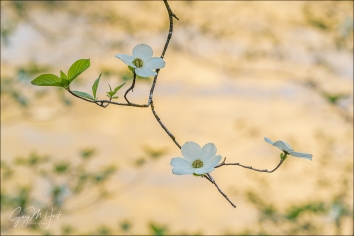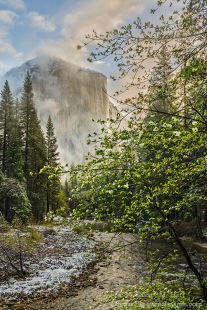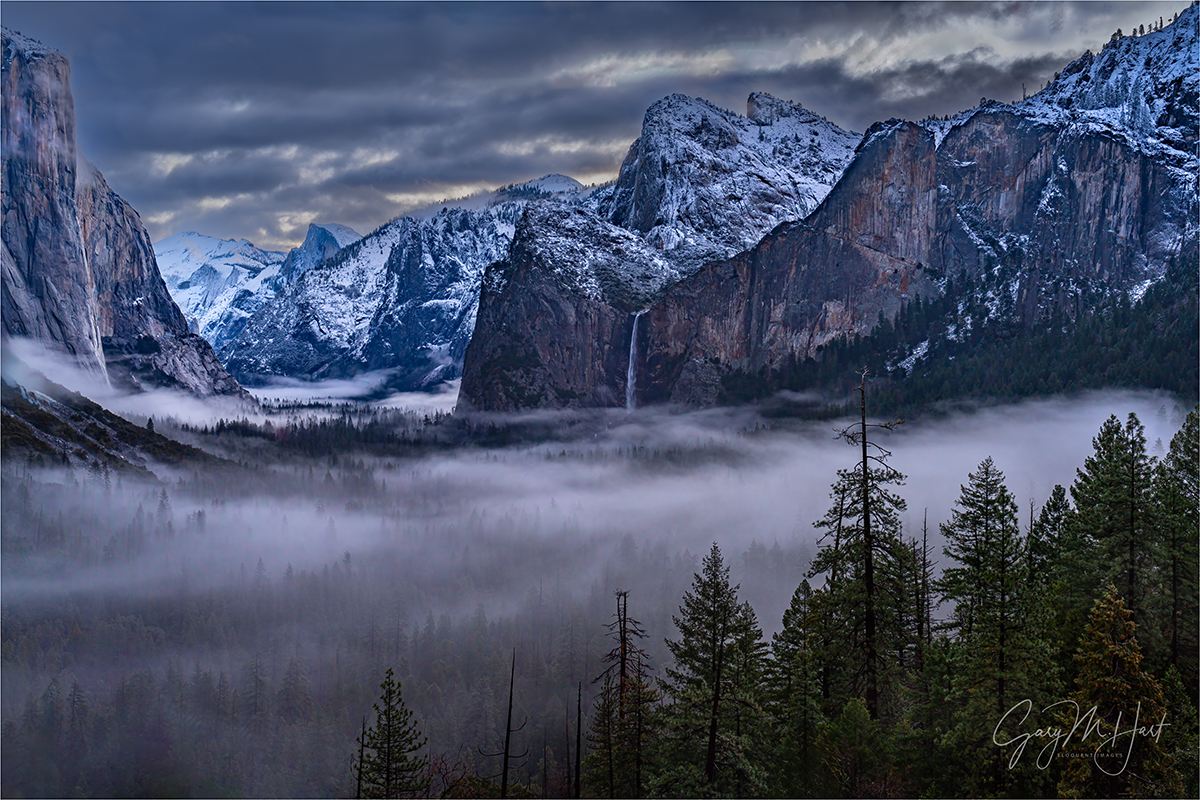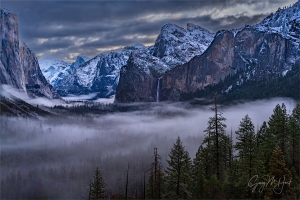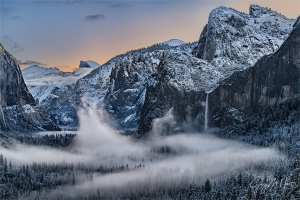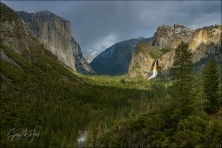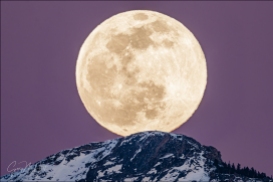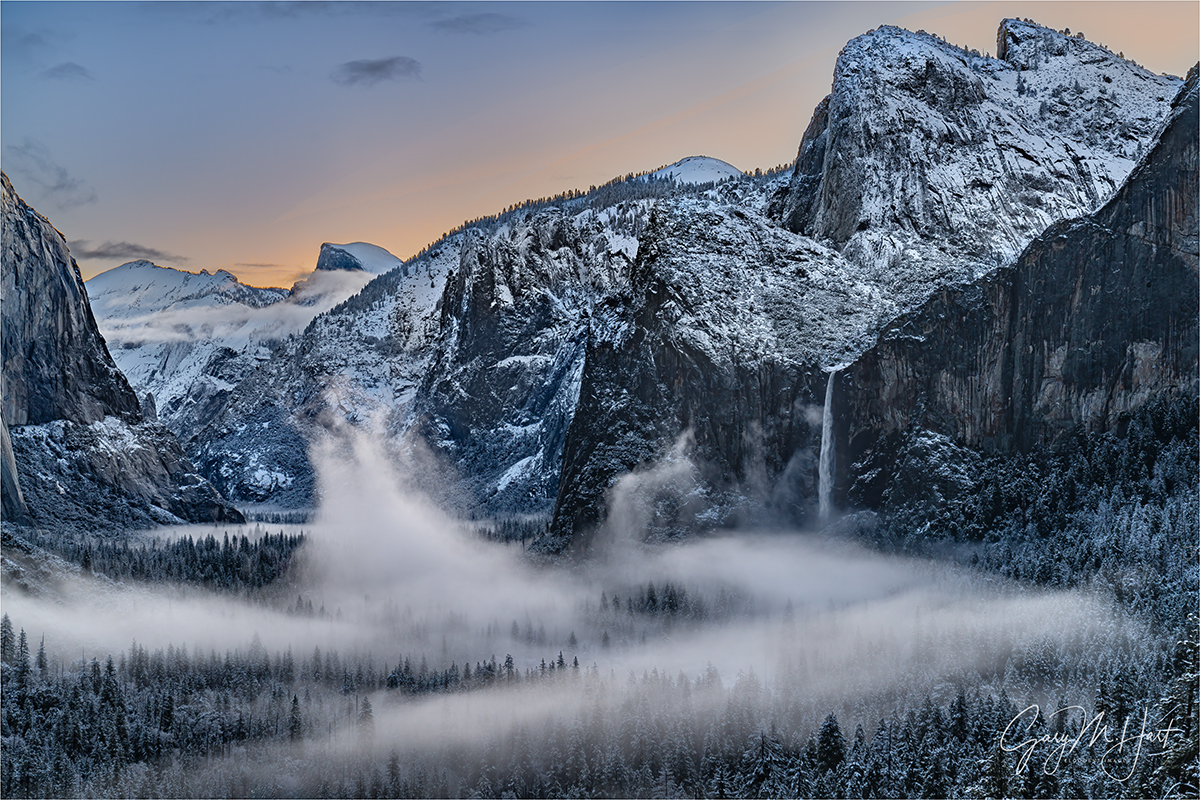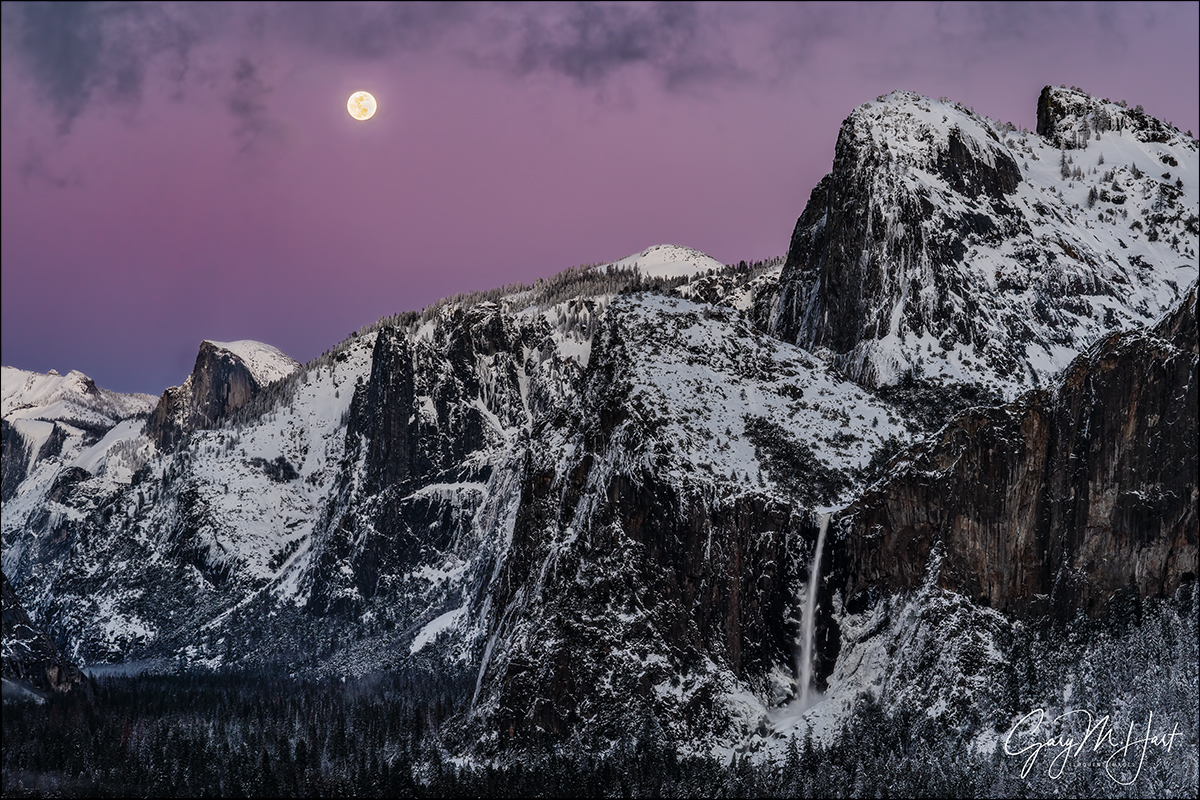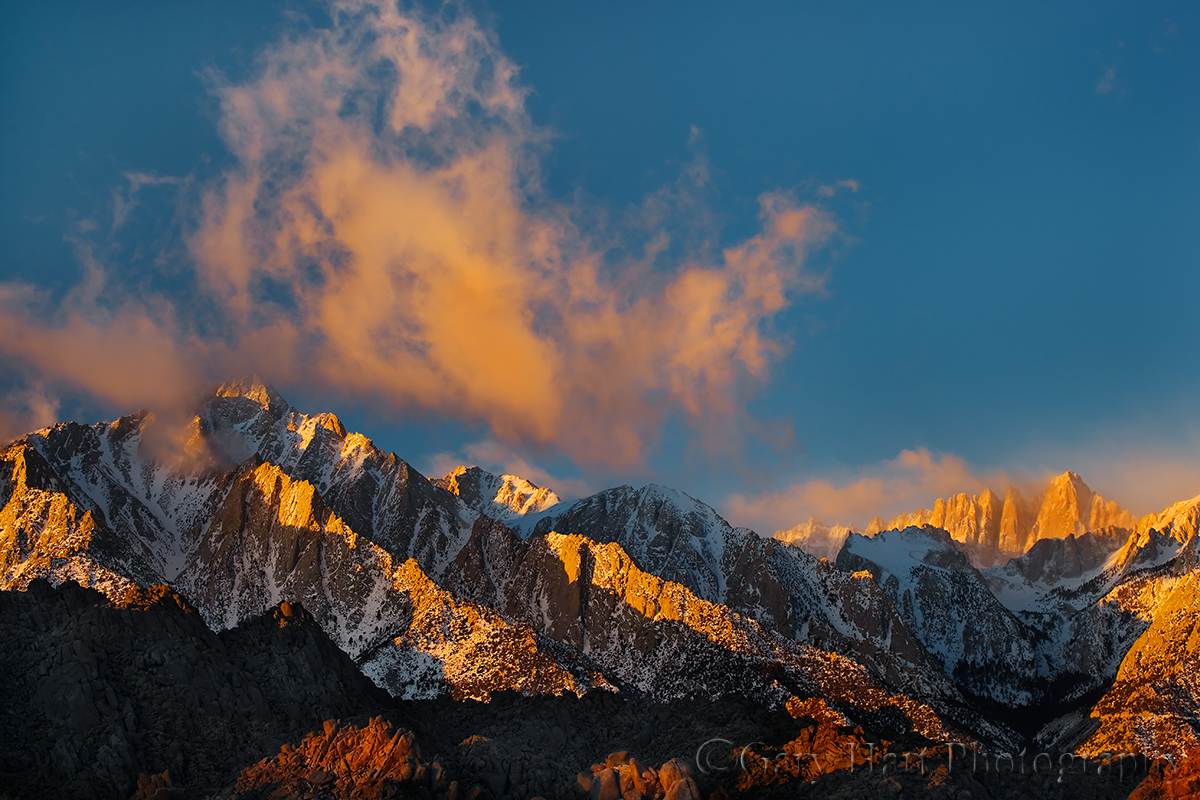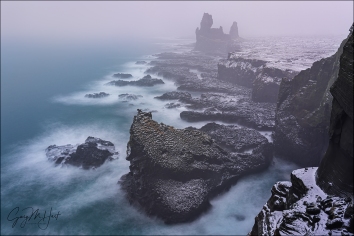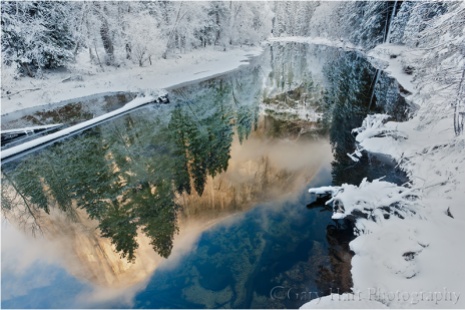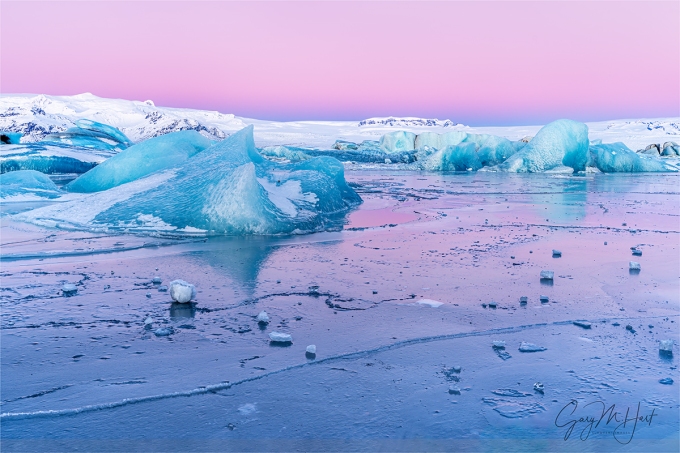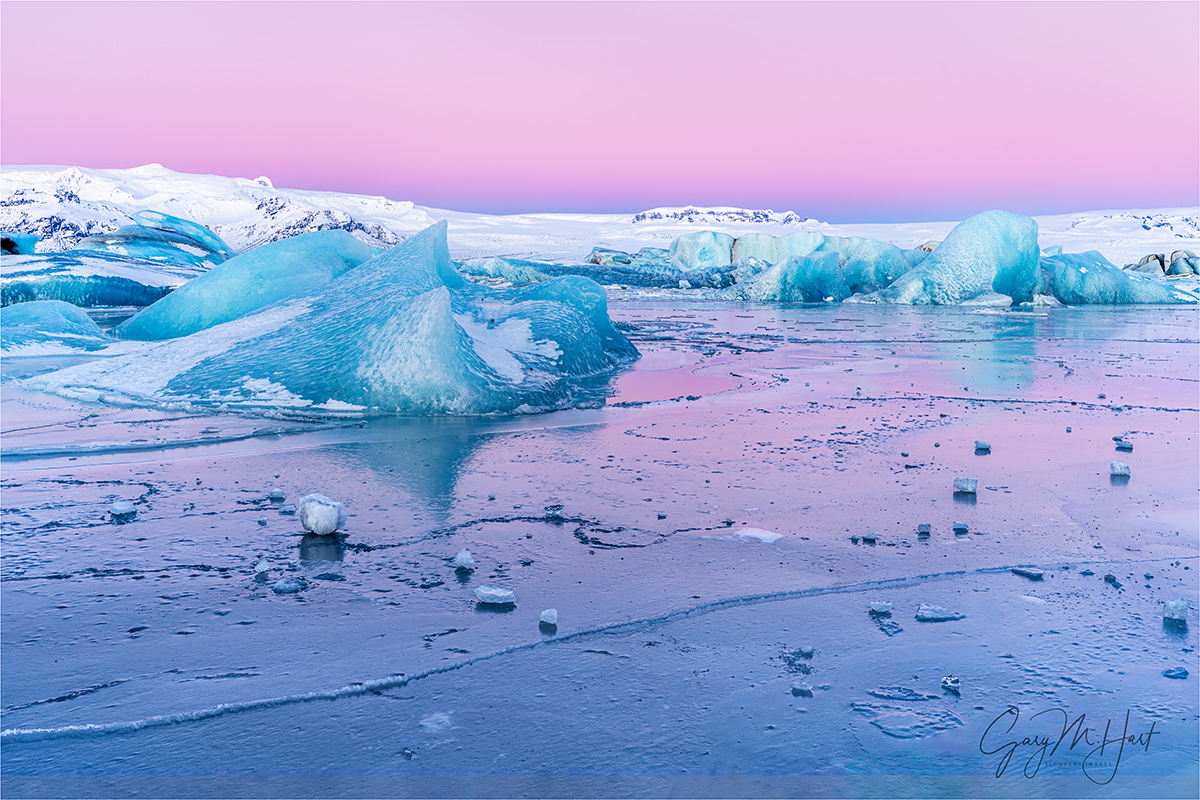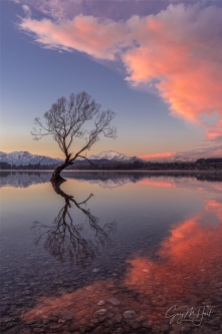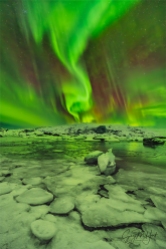Visualize the Future
Posted on May 6, 2024

Twin Falls, Ribbon Fall and Bridalveil Fall, Yosemite
Sony α1
Sony 16-35 f/2.8 GM
ISO 50
f/16
2.5 seconds
Virtually every scene I approach with a camera is beautiful, but a beautiful scene isn’t enough if all the parts don’t work together. Human experience of the world differs greatly from what the camera captures—the photographer’s job is to understand and use those differences.
Ansel Adams and visualization
Most photographers know that Ansel Adams visualized the final print, and the darkroom work necessary to create it, before clicking the shutter. This ability to look into the future of each capture is part of what set Ansel Adams apart from his peers.
But Adams’ extensive darkroom work is often cited by digital photographers defending their over-processesed images. We’ve all heard (and perhaps even uttered ourselves) statements like, “Ansel Adams spent more time in the darkroom than he did in the field,” or “Ansel Adams would love Photoshop.” Perhaps true, but using Ansel Adams’ darkroom mastery to justify extreme Photoshop processing misses a significant point: Adams’ mental picture of the ultimate print was founded upon a synergistic relationship between his vision and his camera’s vision, coupled with a master’s control of capture variables like composition, light, motion, and depth. In other words, Adams’ gift wasn’t merely his darkroom skills, it was an overarching vision that enabled him to make decisions now based on invisible realities he knew he’d encounter later.
I bring this up because I’m concerned about many photographers’ Photoshop-centric “fix it later” approach that seriously undervalues capture technique. This mindset ranges from simple over-reliance on the LCD for exposure with no real understanding of the histogram or how metering works (shoot-review-adjust, shoot-review-adjust, shoot-review-adjust, until the picture looks okay—or shoot so it looks good and not realize the exposure is wrong until they get it on their computer), to photographers who channel their disappointment with an image into an overzealous Photoshop session, pumping color, adding “effects,” or inserting/removing objects until they achieve the ooooh-factor they crave.
The better approach is to understand the potential in a scene while actually viewing it in Nature, camera in hand, then anticipate the processing it will require, then shoot accordingly. In other words, Photoshop should inform capture decisions, not fix them.
Putting Photoshop in its place
Every image ever captured, film or digital, was processed. Just as the processing piece was easy to ignore when the exposed film you sent to a lab magically returned as prints or slides, many digital shooters, forgetting that a jpeg capture is processed by their camera, brag that their jpeg images are “Exactly the way I shot them.” Trust me, they’re not.
Whether you shoot monochrome film, Fuji Velvia slides, or low-compression jpeg, there’s nothing inherently pure about your “unprocessed” image. On the other hand, digital landscape photographers who understand that processing is unavoidable, rather than relinquish control of their finished product to black-box processing algorithms in the camera, usually opt for the control provided by raw capture and hands-on processing.
Unfortunately, Photoshop’s power makes it difficult for many to know where to draw the processing line (myself included). And every photographer draws that line in a different place—one man’s “manipulation” is another’s “masterpiece.” Photoshop isn’t a panacea; its main function should be to complement the creativity already achieved in the camera, and not to fix problems created (or missed) at capture.
While I’m not a heavy Lightroom/Photoshop user, I readily acknowledge that they’re amazing tools that are an essential part of my workflow. I particularly appreciate that LR/PS give the me ability to achieve things possible with black and white film and a decent darkroom, but difficult-to-impossible with the color transparencies I shot for over 25 years. Of course processing is an ever-evolving art itself, one I’m still learning. I’m afraid to this day I find myself mortified by some of my prior processing choices—as I no doubt will be at some later date by processing choices I make today.
Creating an image, from start to finish
Normally when I find myself at a popular Yosemite location like Valley View, I won’t get my camera out unless I can find something that feels truly unique. Last month, not wanting to stray from my workshop group, I was content to observe and assist. But when the clouds draping El Capitan and Cathedral Rocks started turning pink in the evenings last light, I couldn’t resist.
I raced to my car and grabbed my tripod and Sony a1, already loaded with my 16-35 GM lens, and headed down to the large log embedded along the riverbank just downstream from the parking lot. This log has been a Valley View fixture for years, but each year it gets nudged a little by spring runoff—some years more than others. I’m sure it will eventually be swept away entirely.
A trio of photographers was already in place on and around the log, but I saw a spot I could squeeze into and tightroped atop it until I reached them. Despite an extreme language mismatch, we were able to pantomime our way into a friendly equilibrium—lots of smiles and pointing, with a mutual thumbs-up for punctuation—that enabled me to set up in a spot that worked for me without disturbing them.
With the light changing quickly, I went right to work, framing up a wide draft version that included the entire Valley View scene: clouds, Ribbon Fall, El Capitan, Cathedral Rocks, Bridalveil Fall, and the Merced River. I was especially excited to be able to frame the scene with the two prominent waterfalls: well known and year-round Bridalveil on the right, and somewhat anonymous, seasonal Ribbon Fall (Yosemite’s highest vertical drop).
I wasn’t super crazy about the log in the middle of the river, but since it was right in the middle of the scene I wanted to photograph, I decided to lean into it. And while I liked the whitewater, I was less than thrilled by its position in the lower right corner of my frame. Again, just something I’d need to accept.
Balanced atop my log, I raised my tripod as high as I could to prevent the foreground log’s protruding vertical branch from intersecting the far riverbank. To remove distracting texture from the whitewater, I decided to smooth the water with a long shutter speed, dialing to ISO 50 and stopping down to f/16. Exposure was tricky because the sky still held onto a fair amount of light, while the foreground was darkening fast, so I took care to monitor my histogram and managed to find a shutter speed that didn’t wash out the color while still creating a pleasing (to my eyes) motion blur.
The preview image on my LCD looked extremely dark, but I know my camera well enough to know that all the beautiful detail in the shadows would return like magic in Lightroom. Besides pulling down my highlights and dragging up my shadows, and a small color temperature tweak, this turned out to be a relatively simple image to process and get to come out exactly as I’d visualized it that evening.
One more thing
Check out the gallery below. All of these images were captured at Valley View, but rather than base my composition on the “standard” shot here, each takes advantage of whatever conditions were before me at the time. And while a few images do indeed settle for the more conventional composition, my decision to photograph that way was justified (in my mind) by the exceptional conditions that told me I should just get out of the way and let the scene speak for itself. So I guess the moral is, trust your instincts and don’t settle for the obvious—unless the obvious just hits you right over the head and you just can’t ignore it.
Valley View Variety
Click any image to scroll through the gallery LARGE
The Battle of the Brains
Posted on May 3, 2024
Two photographers approach a dense forest festooned with blooming dogwood: One is drawn to a lovely bloom and can clearly visualize a uniquely beautiful image, but he has no idea how to manage his exposure variables to achieve it; the other photographer is so intent on minimizing diffraction while identifying the shutter speed that will freeze the gently swaying bracts without compromising the ISO, that to her, the scene is nothing more than a disorganized assortment of white splashes.
While most photographers don’t fall at these extremes of the creative/analytical continuum, the vast majority do approach their craft with a dominant intuitive or analytical bias, a right-brain versus left-brain struggle with one side or the other significantly stronger than the other. Compounding the problem, rather than simply getting out of the way and letting the strong side do its work, much like an irritating little brother, the less developed (notice I didn’t say “weaker”) side often seems committed to distracting its dominant counterpart.
But every once in a while I run into a photographer who seems to have negotiated a synergistic truce between her conflicting mental camps. She’s able to efficiently analyze and execute the plan-and-setup stage of a shoot, then check-in with her aesthetic counterpart for creative inspiration. As the time to click the shutter approaches, she seamlessly switches between the two camps: the right brain knows how much to soften the background and blur the water, while her left brain knows exactly how to make this happen. The result is images that consistently amaze with their creative inspiration and technical execution.
My job as a photo workshop leader (among other things) is to identify where each photographer falls on this analytical/intuitive spectrum so I can honor and refine the dominant side, and encourage and nurture the less developed side. And after more than 18 years leading photo workshops, I’ve learned that what most photographers perceive as a terminal shortcoming in their creative or analytical aptitude can usually be resolved once it’s untangled from the dominant side.
When I hear, “I have a good eye for composition…,” I know before the “but” exits the photographer’s lips that I’ll need to prove that he’s smarter than his camera (he is). Our time in the field will be spent working on jettisoning the camera’s automatic modes because as smart as it might seem, your camera is not creative. I try to demystify and simplify metering, exposure, and depth management until they become second nature, comforting allies rather than distracting antagonists. Fortunately, despite the fact that much of the available photography education seems designed to intimidate Einstein, laying a foundation for mastering photography’s technical side is ridiculously simple.
On the other hand, before the sentence that starts, “I know my camera inside and out…,” is finished, I know I’ll need to foster this photographer’s curiosity, encourage experimentation, and help her disengage the rules that constrain her creativity. We’ll think in terms of whether the scene feels right, and work on what-if camera games (“What happens if I do this”) that break rules. Success won’t require a brain transplant, she’ll just learn to value and trust her instincts.
Intuition is the key to breaking the rules that inhibit creativity, while simplification and repetition create technical confidence. Alone, these qualities are incomplete; in conflict, they’re mutually exclusive anchors that prevent movement; in concert, their synergy is the foundation of photographic success.
For example
Coincidentally, just this week I happed to find myself in a dense forest festooned with blooming dogwood. Go figure. A few minutes earlier I’d set my workshop group free just upstream from Valley View, and after making sure everyone was content, I grabbed my camera, tripod, and 200-600 lens and went dogwood hunting.
I started by switching on my creative brain and wandering slowly, scanning the surroundings for a dogwood flower (yes, I know they’re technically not flowers, they’re bracts) to isolate from its surroundings. Eventually I made my way across the road, and soon my eyes landed on a single bloom swaying gently in full shade. Its slightly green tint and pristine center (this is where the actual dogwood flowers reside) told me this specimen was young—exactly what I was looking for.
Instead of framing my subject up and clicking, I scanned the background and found a branch with more young flowers a couple of feet away. Positioning myself to align my target flower with the background flowers, I framed up a vertical composition. Briefly engaging my analytical brain, I opened my aperture wide for the absolute softest background, increased my ISO to mitigate the effects of the breeze, and focused on the dogwood’s center. Then I dial my shutter speed until the histogram looked right, checking to be sure my chosen speed could freeze the flower”s gentle bobbing.
My favorite moment when doing these creative selective focus shots is the instant my subject snaps into focus. Suddenly, the world in my viewfinder is completely different from the one outside my camera. In addition to the pillowy background flowers, I liked the way a few rays of sunlight had penetrated the dense branches overhead to illuminate a couple of green leaves in my frame.
My creative brain really liked the framing I’d found, but thought the background could use just a little more definition. So back to my analytical brain I went, stopping down to f/10—just enough to distinguish individual flowers in the soft background. But stopping down also reduced my exposure—since I couldn’t increase my shutter speed to add light, instead I increased my ISO knowing that whatever noise the higher ISO introduced would easily clean up in processing. Click.
Of course this creative/emotional switching doesn’t really happen consciously anymore, but there was a time when I was far more deliberate about the distinction. Like most things in life, the longer I do this, the more unconscious and seamless this switching becomes, and the better my two sides play together.
Workshop Schedule || Purchase Prints || Instagram
More Dogwood!
Click any image to scroll through the gallery LARGE
Happy Earth Day
Posted on April 26, 2024
My commitment for this blog is one image/post per week. With a workshop that started Sunday and ended Wednesday, I’m a little behind this week, but I made it! Next week I have a workshop that goes from Monday through Thursday, and the following week I’ll be completely off the grid rafting the Grand Canyon. But one way or the other, I’ll continue with my once per week commitment, even if I’m a little late. And if I do have to skip a week, I’ll catch up eventually, I promise. I return you now to your regular programming…
Happy Earth Day to you
How did you celebrate Earth Day (April 22) this year? I was fortunate enough to celebrate up close and personal, guiding a workshop group around Yosemite. It’s easy to appreciate a planet when you’re surrounded by some of its most exquisite beauty, and with a group of people who appreciates it as much as you do, but every time I visit, I’m reminded that we may in fact be loving our wonders to death.
It’s impossible to have zero impact on the natural world. Every day, even if we never leave the house, we consume energy that, directly or indirectly, pollutes the atmosphere and contributes the greenhouse gases that warm our planet. The problem only worsens when we venture outdoors. Our vehicles belch exhaust, or consume electricity that was the product of invasive mining. At our destination, the clothing we wear introduces microscopic, non-indiginous flora and fauna, while the noise we create clashes with the natural sounds that comfort others and communicate information to animals. Even foot travel, the oldest, most fundamental mode of transportation, crushes rocks, plants, and small creatures with each footfall. And let’s not forget the artificial light that dilutes our once black night sky.
I’m not suggesting that we all hole up beneath a rock. If everyone just considered how their actions impact the environment and acted responsibly, our planet would be a better, more sustainable place.
Let’s get specific
The damage that’s an unavoidable consequence of keeping the natural world accessible to all is a tightrope our National Park Service does an excellent job navigating. With their EVs, organic, and recycling mindset, it’s even easy for individuals to believe that the problem is everyone else.
I mean, who’d have thought merely walking on “dirt” could impact the ecosystem for tens or hundreds of years? But before straying off the trail for that unique perspective of Delicate Arch, check out this admonition from Arches National Park. And Hawaii’s black sand beaches may appear unique and enduring, but the next time you consider scooping a sample to share with friends back on the mainland, know that Hawaii’s black sand is a finite, ephemeral phenomenon that will be replaced with “conventional” white sand as soon as its volcanic source is tapped–as evidenced by the direct correlation between the islands with the most black sands beaches and the islands with the most recent volcanic activity.
Sadly, it’s Earth’s most beautiful locations that suffer most. Yosemite’s beauty is no secret—to keep it beautiful, the National Park Service has been forced to implement a reservation system to keep the crowds (marginally) manageable. Similar crowd curtailment restrictions are in place, or being strongly considered, at other national parks. And while the reservations have helped in Yosemite and elsewhere, the shear volume of visitors who make it through guarantees too much traffic, garbage, noise, and too many boots on the ground.
While Yosemite’s durable granite may lull visitors into environmental complacency, it is now permanently scarred by decades of irresponsible climbing. And Yosemite’s fragile meadows and wetlands, home many plants and insects that are an integral part of the natural balance that makes Yosemite unique, suffer from each footstep to the point than some are now off-limits.
A few years ago, so many people crowded the elevated bank of the Merced River to photograph Horsetail Fall’s sunset show, the riverbank collapsed—that area is now off limits during Horsetail season. Despite all this, I can’t tell you how often I see people in Yosemite cavalierly trampling meadows to get in position for a shot, as a trail shortcut, or to stalk a frightened animal.
Don’t be this person
Despite the damage inflicted by the sheer volume of garden variety tourists, my biggest concern is the much smaller cohort doing a disproportionate amount of damage: photographers. Chasing the very subjects they put at risk, photographers have a vested interest and should know better. But as the urge to top the one another grows, more photographers seem to be abusing nature in ways that at best betrays their ignorance of the damage they’re doing, and at worst reveals their startling indifference to the fragility of the very subjects that inspire them to click their shutters in the first place.
If I can’t appeal to your environmental conscience, consider that simply wandering about with a camera and/or tripod labels you, “Photographer.” In that role you represent the entire photography community: when you do harm as Photographer, most observers (the general public and outdoor decision makers) simply apply the Photographer label and lump all of us, even the responsible majority, into the same offending group.
Like it or not, one photographer’s indiscretion affects the way every photographer is perceived, and potentially brings about restrictions that directly or indirectly impact all of us. So if you like fences, permits, and rules, just keep going wherever you want to go, whenever you want to go there.
It’s not that difficult
Environmental responsibility doesn’t require joining Greenpeace or dropping off the grid (not that there’s anything wrong with that). Simply taking a few minutes to understand natural concerns specific to whatever area you visit is a good place to start. Most public lands have websites with information they’d love you to read before visiting. And most park officials are more than happy to share literature on the topic (you might in fact find useful information right there in that stack of papers you jammed into your car’s center console as you drove away from the entrance station).
Most national parks have non-profit advocacy organizations that do much more than advocate, maintaining trails and underwriting park improvements that would otherwise be impossible. For example, the Yosemite Conservancy funded Bridalveil Fall’s recently completed (significant) upgrade that included new flush toilets (yay!), new trails and vistas, and enhanced handicapped access.
If you spend a lot of time at a national park, consider supporting its non-profit partner. The two I belong to are Yosemite Conservancy and Grand Canyon Conservancy.
Develop a “leave no trace” mindset
Whether or not you contribute with your wallet, you can still act responsibly in the field. Stay on established trails whenever possible, and always think before advancing by training yourself to anticipate each future step with the understanding of its impact. Believe it or not, this isn’t a particularly difficult habit to form. Whenever you see trash, please pick it up, even if it isn’t yours. And don’t be shy about gently reminding (educating) other photographers whose actions risk soiling the reputation for all of us.
A few years ago, as a condition of my national parks’ workshop permits, I was guided to The Center for Outdoor Ethics and their “Leave No Trace” initiative. There’s great information here–much of it is just plain common sense, but I guarantee you’ll learn things too.
Armed with this mindset, go forth and enjoy nature–but please save some for the rest of us.
About this image
When I started taking pictures, long before the dawn of digital, my emphasis was outdoor subjects ranging from natural landscapes to urban skylines and bridges. But as my eye and overall relationship with the world has evolved, I’ve gravitated naturally toward landscapes and away from the cityscapes.
I understand now that this evolution has much to do with my love (and concern) for the natural world, both the beauty that surrounds us and damage we’re doing, and a desire to honor it. In recent years I’ve very consciously striven to, as much as possible, create images that allow people to imagine our planet untouched by humans—perhaps hoping that they’ll understand what’s at risk somehow do their share to stem the tide.
Though only number six on the current list of most visited national parks, Yosemite needs to cram the vast majority of its nearly 4-million annual visitors into the less-than 10 square miles of Yosemite Valley. In fact, for more than half the year, almost all of the park outside of Yosemite Valley is smothered in snow and closed to vehicles. This creates congestion and other problems that are unique to Yosemite.
One of the most beloved vistas on Earth, Tunnel View attracts gawkers like cats to a can-opener—all I have to say about that is, “Meow.” Despite its popularity, and the fact that the vista has indeed been crafted by the NPS (paved parking, enclosed by a low stone wall, and many trees removed to maintain the view), Tunnel View remains one of my favorite places to imagine a world without human interference.
My history with Tunnel View in Yosemite dates back to long before I ever picked up a camera, but I never take it for granted. Each time I visit, I try picture Yosemite before paintings, photographs, and word of mouth eliminated the possibility for utter surprise and awe, and what it must have been like to round a corner or crest a rise to see Yosemite Valley unfolding before you (earlier views of Yosemite were not at the current location of Tunnel View, but the overall view and experience were similar).
Today, unless I’m there for a moonrise, I rarely take out my camera at Tunnel View, preferring instead to watch the reaction of other visitors—either my workshop students or just random tourists. But every once in a while, the scene is too beautiful to resist. That happened twice for me in February, when I added two more to my (arguably already too full) Tunnel View portfolio: today’s image and the one I shared last week.
This week’s image came in the first workshop, before sunrise following an overnight rain. Though the compositions are similar, the moods of the two images are completely different. First, in last week’s image, the valley sported a thin glaze of snow, while the overnight temperatures for this week’s image weren’t quite cold enough to turn the rain to snow in Yosemite Valley (though we did find some had fallen on the east side of the valley).
But to me the biggest difference between the two images is the mood. In the snowy image I shared last week, the storm had moved on and the sky had cleared—most of the remaining clouds were local, radiating from the valley floor. The warm light of the approaching sun coloring the sky gives the scene a brighter, more uplifting feel.
The new image I share this week came during a break in the storm, but not at its end. With more rain to come, the moisture-laden sky darkened and cooled the scene, creating a brooding atmosphere. I especially like these scenes for the way they convey the timeless, prehistoric feel I seek.
Workshop Schedule || Purchase Prints || Instagram
Tunnel View Views
The Other AI
Posted on April 16, 2024
What’s wrong with ACTUAL intelligence (the other AI)?
I love all the genuine eclipse photos popping up on social media—almost as much as I DESPISE all the fake eclipse photos. Though we’ve had to deal with a glut of fabricated photos since the introduction of computers and digital capture to photography (all the way back before the turn of the 21st Century), the advent of artificial intelligence, combined with insatiable social media consumption, has put the bogus image problem on steroids. Despite being downright laughable, these AI frauds seem to fool a disturbing number of viewers. More concerning, many who claim they’re not fooled claim they don’t care because they still find these AI-generated fakes “beautiful.”
Acknowledging that beauty is in the eye of the beholder, all I can do is shrug and offer that my own definition of beauty is founded on truth. Not necessarily a perfect reproduction, or repetition of literal fact, but an overarching connection to some essential reality.
Whether it’s a painting, a work of fiction, a photograph, or any other artistic creation, I need to feel that essential truth connecting the scene, the artist, and me. The reality in a work of art—visual, musical, written, or whatever—doesn’t need to be, in fact usually isn’t, a literal reproduction of the world as I know it. Rather, I prefer artistic creations that reveal a previously unseen (by me) truth about the world. In other words, while paintings are rarely literal interpretations of the world (and in fact can be quite abstract), and novels by definition aren’t factual, the artistic creations I’m drawn to tap the creator’s unique take on reality to expand my own.
Even photographs, once relied on as flawless reproductions of reality, can’t possibly duplicate our 3-dimensional, unbounded, dynamic, multi-sensory reality. But they can, in the right hands, leverage the camera’s reality to expose hidden truths about the world. No matter how “stunning” an AI-generated or dishonest composite (two or more unassociated scenes in one image) image might be at first glance, they lack the artist’s perspective, or any connection to reality, sometimes both. Even worse, counterfeit images pretend to represent a reality that doesn’t exist. While it may be possible for an AI creation to require genuine human insight and creativity, so far all I see is people using AI as a shortcut around actual intelligence.
Of course photographic deception started long before digital capture, but like so many other things computers simplified, digital capture made it easy for people more interested in attention than connection to attract the strokes they covet. At least in the film days, manipulating a photo still required a bit of skill and effort—back then, when it was done honestly, you could at least admire the perpetrator’s skill.
Full disclosure (I digress)
I have to confess that I was actually party to blatant image manipulation at the age of 11, when my best friend Rob and I did a sixth grade Science Fair project on UFOs. In Rob’s backyard (and with help from Rob’s dad), we first photographed a homemade styrofoam “flying saucer” suspended on a wire against a plain tarp. Next, without advancing the film, we photographed our school, then sent the film off to be processed (who remembers those days?).
A few days later, we had a pretty convincing black-and-white print of our school beneath a hovering UFO. But, since our sole goal was to prove how easy it is to fake a UFO sighting, we did reveal the sleight-of-camera trick in our presentation (so no harm, no foul).
The digital dilemma
The introduction of computers to the world of photography, even before digital camera’s were anything more than a promising novelty, created an almost irresistible temptation for photographers who lacked the ethic or inspiration to create their own images. At the time, with no consensus on where to draw the line on digital manipulation, some photographers innocently stepped over the spot where most of us would draw it today.
For example, in the mid-90s, when Art Wolfe cloned extra zebras into his (already memorable) zebra herd image, many cried “Foul!” Wolfe, who had no intent to deceive, was taken aback by the intensity of the blowback, arguing that the resulting image was a work of art (no pun intended), not journalism.
In the long run, the discussion precipitated by Wolfe’s act probably brought more clarity to the broader digital manipulation issue by forcing photographers to consider the power and potential ramifications of the nascent technology, and to decide where they stood on the matter. Expressing his disapproval in a letter to his friend Wolfe, renowned landscape photographer Galen Rowell probably said it best: “Don’t do anything you wouldn’t feel comfortable having fully revealed in a caption.” Great advice that still applies.
Nevertheless, left up to each photographer, the “how much manipulation is too much” line remains rather fuzzy, but I think most credible photographers today agree that it excludes any form of deception. Which brings me back to the absolutely ridiculous eclipse fakes we’ve all been subjected to. I honestly don’t know what upsets me more—the fact that “photographers” are trying to pass these fakes off as real, or the number of people who they fool. (And I won’t even get into the fact that every image and word I’ve shared online has almost certainly been mined to perpetrate AI fabrication—that’s a blog for a different day.)
One risk of that mass gullibility, and people’s apathy about the distinction between real and artificial, is the dilution of photography’s perception in the public eye. As beautiful as Nature is without help, it’s pretty hard to compete with cartoonish captures when a connection to reality isn’t a criterion. I’m already seeing the effects—the volume of enthusiastic praise for obvious fakes is disturbing enough, but even more disturbing to me is the number of people responding to legitimate, creative, hard-earned images with skepticism.
So what can we do?
I’m not sure there is a complete solution to the AI problem, but I hope that enough people crying “Foul!,” on social media and elsewhere, will open eyes and force discussions that might help the public draw a line—just as the zebra debate did three decades ago. If the blowback is strong enough, perhaps even the potential stigma will be enough to discourage AI purveyors and consumers alike.
As much as I appreciate people calling out AI perpetrators in the comments of obviously fake social media posts—I’ll do this occasionally myself when I think I can contribute actual insight that might help some understand why an image is fake—I’m afraid these well-intended comments get so buried (by the “Stunning!” and “Breathtaking!” genuflections) that very few people actually see them. So one step I’ve started taking with every single fake image that soils my social media feeds is to permanently hide all future posts from that page/profile/poster. I’m probably fighting a losing battle, but at least this unforgiving, one-strike-and-you’re-out policy gives me a little satisfaction each time I do it.
About this image
One thing a still photo can do better than any other visual medium, better even than human vision, is freeze a moment in time. From explosive lightning, to crashing surf, to a crimson sunset, to swirling clouds, Nature’s most beautiful moments are also often its most ephemeral. No matter how much we believe at the time that we’ll never forget one of these special events, sadly, the memory does fade with time. But a camera and capable photographer, in addition to revealing hidden aspects of the natural world, records the actual photons illuminating those transient moments so they can be revisited and shared in perpetuity.
Which was the very last thing on my mind as this year’s February workshop group and I pulled into the Tunnel View parking lot in the predawn gloaming of this chilly morning. Instead, we were abuzz with excitement about the unexpected overnight snow that had glazed every tree and rock in Yosemite Valley with a thin veneer of white.
Our excitement compounded when we saw the scene unfolding in Yosemite Valley below. One of my most frequent Yosemite workshop questions is some version of, “Will we get some of that low fog in the valley when we’re at Tunnel View?” My standard answer is, “That’s only in the Deluxe Workshop,” but they rarely accept that. The real answer is, while this valley fog does happen from time-to-time, it’s impossible to predict the rare combination of temperature, atmospheric moisture, and still air it requires. (It’s much easier to predict the mornings when it absolutely won’t happen, which is most of them.)
But here it was, almost as if I’d ordered it up special for my group. (I tried to take credit but don’t think they were buying it.) Since I’ve seen this fog disappear as suddenly as it appears, or rise up from the valley floor to engulf the entire view in just a matter of seconds, as soon as we were parked I told the group to grab their gear and hustle to the vista as fast as they can. Then I did something I rarely do at Tunnel View anymore: I grabbed my gear and hustled to the vista as fast as I could.
While Tunnel View is one of the most beautiful views I’ve ever photographed, I’ve been here so many times that I usually don’t get my gear out here anymore—not because I no longer find it beautiful, but because it’s a rare visit that I get to see something I’ve not seen before. But since the view this morning, while not unprecedented, was truly special, I just couldn’t help myself. Another factor in my decision to photograph was that here we can all line up together, allowing me to check on and assist anyone who needs help, and still swing by my camera to click an occasional frame. This morning everyone seemed to be doing fine, so I was actually able to capture a couple of dozen frames as the fog danced below.
There were a lot of oohs and ahhs when a finger of fog rose from the valley floor and pirouetted toward Half Dome. There were many ways to photograph it, but I chose to frame it as tightly as possible, ending up with a series of a half-dozen of this particular fog feature before it morphed into something completely different. I included minimal sky because the sky above El Capitan, Half Dome, and Cathedral Rocks was relatively (compared to the rest of the scene) empty and uninteresting.
With the fog continuously shifting, to avoid cutting off any of the zigzag beneath Bridalveil Fall, I had to be extremely conscious of its spread. Depth of field wasn’t a concern because everything in my frame was at infinity. The most challenging aspect was exposure of the bright sky with the fully shaded valley. To get it all, I underexposed the foreground enough to spare the warmth of the approaching sun. The result was a virtually black foreground and colorless sky on my camera’s LCD, but I took special care to monitor my histogram and ensure that I’d be able to recover the shadows in Lightroom/Photoshop.
So, as you can see from my description, I did indeed leverage digital “manipulation” to create the finished product I share here. But my processing steps were designed to brighten the nearly black foreground my camera captured, because exposing it brighter would have resulted in a completely white sky. Since neither a white sky or a black foreground were anything close to our experience this morning, I applied actual intelligence to expose the scene and create an image that more closely reflects this actual (and unrepeatable) event in Nature.
My group rose in the frigid dark and stood bundled against the icy cold to witness this scene and capture permanent, shareable memories of our glorious morning. I imagine it might have be possible for us to have stayed in our cozy hotel rooms, open our computers, and input a few prompts in an AI image generator to come up with something similar (and why not throw in a rainbow, lightning bolts, and rising moon while we’re at it?). But where’s the joy in that?
Ephemeral Nature
Click any image to scroll through the gallery LARGE
There’s No Whining in Photography
Posted on April 10, 2024
Do I need to tell you it was brutally cold this afternoon? Of course not (and I doubt anyone really wants to hear me whine about it anyway).
I also probably don’t need to tell you that this scene was spectacularly beautiful. And unfortunately, these two facts are often inexorably intertwined because the best time for photography is usually the worst time to be outside. As nice as it is to stroll up to a scene in shorts and flip-flops to discover the image of my dreams just waiting for me, the majority of my most memorable images required some degree of suffering.
That suffering can take many forms, but whenever I start feeling sorry for myself, I remind myself that most of my favorite images were earned. I say this less to pat myself on the back than to force me back outside when my resolve starts wavering.
With this in mind, many years ago I created a simple mnemonic that describes the effort-centric mindset that consistently good photography requires that I call, “The 3 P’s of Nature Photography”: Preparation, Persistence, and Pain.
Let’s review
1: Preparation is your foundation, the mastery of your craft combined with the creative vision that allows you to wring the most from every moment in nature. It’s the location experience you’ve earned, the craft you’ve worked hard to perfect, the research that puts you in the right place at the right time, and your ability to see the world the way your camera sees it.
Prepared photographers possess a firm grasp of exposure and hyperfocal focus techniques. They research their subjects to understand when the light will be best, where and when the wildflowers bloom, and the precise time and place of the full moon’s appearance above their favorite landscape. They know at capture how they’ll leverage their processing skill for the best possible result.
The moon’s arrival above Yosemite Valley on this snowy February evening was no fluke—it had been on my radar for over a year, and I’d arranged my schedule to ensure that I wouldn’t miss it. So, while (from all appearances) most of the photography world shivered in Yosemite Valley with their cameras trained on Horsetail Fall, waiting for the fickle sunlight to do its unpredictable thing, my camera and I were set up with a small cohort of similarly prepared photographers at Tunnel View, anticipating the moon’s arrival. As is often the case, the Horsetail Fall crowd was disappointed this evening; the moon chasers were not.
But just being there wasn’t enough, because photographing a daylight bright moon above a landscape washed in diminishing post-sunset shadow is an extremely tricky exposure.
2: Persistence is patience—with a dash of stubbornness. It’s the determination that keeps you going back when the first, second, or hundredth attempt has been thwarted by unexpected light, weather, or a host of other frustrations. Persistence keeps you out there when the chances look bleak, and sends you over that next rise when there’s no sign of reward.
With virtually no control over our subjects, nature photographers soon learn that persistence is sometimes the only fuel that keeps us going, and we all have stories of rewards that more than compensate for the far greater number of failures.
Many years ago my brother and I holed up for several days beneath a solid gray deck of low clouds above Lone Pine, waiting for the clouds to lift enough for Mt. Whitney to come out to play. Every morning we’d drive up into the Alabama Hills full of hope to wait for a sunrise that never happened. With a weather forecast that promised snow along our route home, we had every reason to forego photography and hit the road early on our final morning. But we drove back up into the Alabama Hills one last time, and were finally rewarded when the clouds broke up just as the rising sun illuminated the Sierra Crest.
3: Pain is the willingness to suffer for your craft. I’m not suggesting that you risk injury or death for the sake of a coveted capture, but you do need to be able to experience more than a little discomfort, and to ignore the tug of a warm fire, full stomach, sound sleep, and dry clothes, because the unfortunate truth is that the best photographs usually seem to happen when most of the world would rather be inside.
Pain and persistence often go hand-in-hand, and the ability to persist is often a function of your tolerance of the pain it brings—not just physical pain, but the monotony of repetition or just enduring minutes or hours of absolutely nothing happening. For most photographers, there’s a direct correlation between the joy an image brings and the pain experienced pursuing it.
My day at Lake Wanaka in New Zealand had started long before dawn with a walk along the lakeshore to spend sunrise with this truly special tree and its reflection. Sunrise was nice, but we weren’t done, not even close. From there our group drove three hours to Aoraki / Mt. Cook National Park, making several stops along the way for more hikes and beautiful winter photography. We wrapped up the day, or so I believed, waiting for darkness to reveal the Milky Way over Tasman Lake. Following our Milky Way shoot, we walked back to the van in the dark, and made the three-hour drive back to Wanaka to wrap up the longest photography day of my life.
The return drive was made even longer by dense fog that hugged most of our route back. Thoroughly exhausted, at our Wanaka hotel, where warm beds beckoned, I glanced skyward and saw stars. Somehow that sight infused me with a second wind and rather than return to my room, I beelined back to the lake.
It was so dark that at first I couldn’t find the tree—had I hiked too far? Not far enough? After a couple of test images to orient myself, I started working on the scene. I was aware of the cold, but strangely unaffected by it, something that photography seems to do to me. I got in about 30 minutes of joyful photography before the fog expanded and swallowed the scene.
So which of my 3 P’s do I credit for this one?
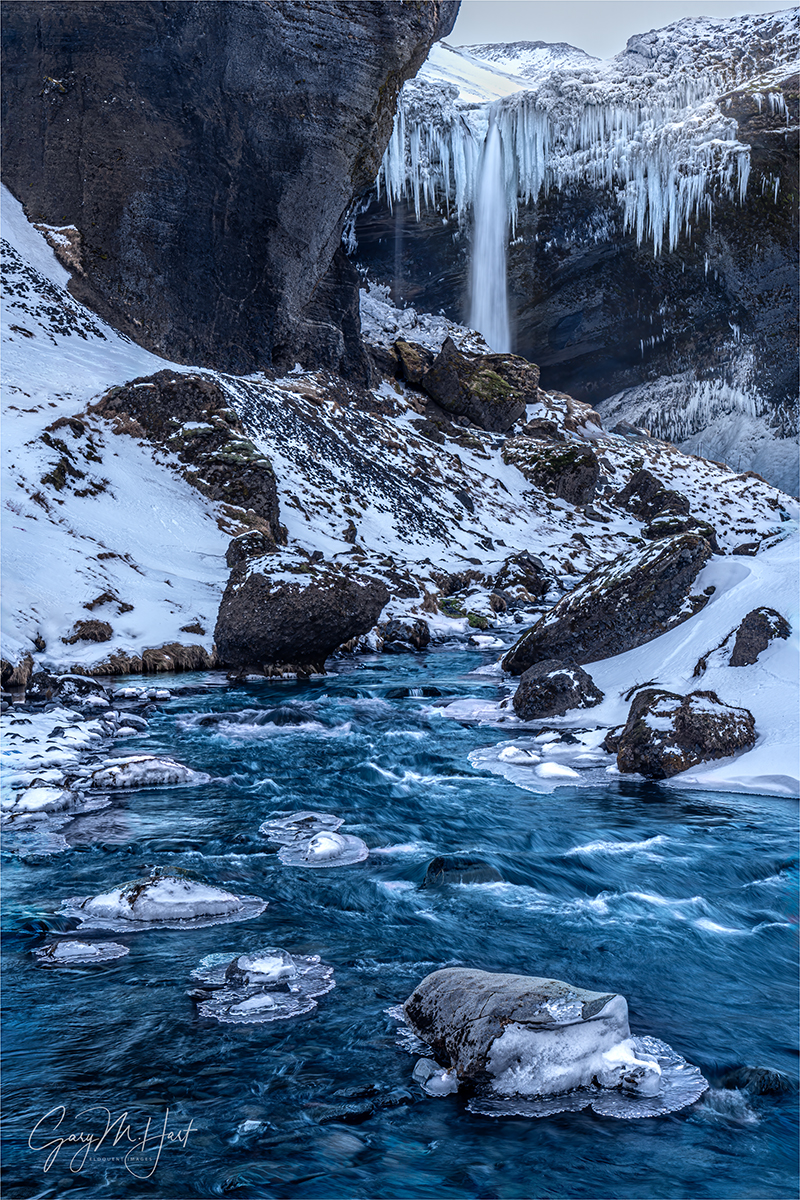
Icewater, Kvernufoss, Iceland
This image was all about the Pain. I captured it just couple of months ago, on the last full day of the Iceland winter workshop that Don Smith and I do each year.
Having never been to Kvernufoss, we took the word of the two photographers Don and I had hired to guide this year’s group, Albert Dros and Vincenzo Mazza, that it was worth the one mile hike. As you can see, they were right.
My difficulty (pain) this frigid afternoon was exacerbated by the fact that a couple of days earlier the crampons that had enabled me to successfully navigate Iceland’s frequently treacherous icy footing had mysteriously disappeared, making each outdoor step a potential disaster. Not knowing the trail, I had no idea whether I’d make it to the fall without my crampons, but I didn’t want to miss a new waterfall. Most of the hike turned out to have a slight uphill grade that was not too icy and much easier to navigate than I’d feared, but as we crested a rise and got our first look at the fall, I saw that the trail descending to the fall was quite icy.
That first view was quite beautiful—so beautiful that it would have been very easy to just set up there and go no farther. But I really wanted to get closer. Slowed by my banana peal boots, I quickly fell behind the group. As I cautiously descended, I could see that many in the group had actually followed the trail behind the fall, a potentially very cool perspective. But the trail kept getting icier, and after witnessing several people with crampons fall hard and struggle to navigate the trail’s final stretch, I reset my plan about 150 feet from the fall.
Resigned to Plan B, I decided to focus my attention on the ample opportunities nearby: glacial blue-green river punctuated with icy disks, snowy riverbank, and plunging waterfall framed by spear-like icicles. I tried a few frames firmly planted on the main trail, but knew I could better emphasize the river and ice by getting down to river level. Hmmm…
I spied a short, narrow trail curving down to the river and gingerly made my way down, concentrating with each shuffle-step lest I reprise (a winter version of) the Romancing the Stone mudslide scene. Safely down at the river, I planted myself back on solid (-ish) footing and framed up a scene in my viewfinder. With each peek, decided I needed to be closer to river level to make the water and ice as prominent as possible, slightly lowering my tripod each time. When I finally started working the scene from river level, I realized I should have just bypassed all those incremental tripod steps and plopped straight down, but (speaking of “pain”) the older and colder I get, the more difficult the simple act of dropping to ground level becomes (and don’t even get me started on getting back up).
Grateful for my heavy duty, waterproof down parka that goes down to mid-thigh, I plopped my butt down onto the snow to position myself closer to eye level with my viewfinder—and to minimize my chances of ending up in the river. I framed the scene to maximize the nearby ice disks, minimize the flat gray sky, and eliminate distractions along the riverbank. The trickiest part was finding a clean border with minimal subjects cut off or jutting in, but I finally found something I was pretty satisfied with. Because sharpness throughout my frame was essential, and the closest ice was just a few feet away, I stopped down to f/18 and focused on the second ice disk. To add a little blur to the water, I dialed to ISO 50.
While it would have been easy to complain about the cold, or to feel sorry for myself for missing my crampons, I was here by choice. Scenes like this are exactly why I do this photography thing—and a perfect reminder why there really is no whining in photography.
Join Don and me in Iceland
Workshop Schedule || Purchase Prints || Instagram
To the Pain
Click any image to scroll through the gallery LARGE
Bonus Blog: Eclipse Special
Posted on April 5, 2024
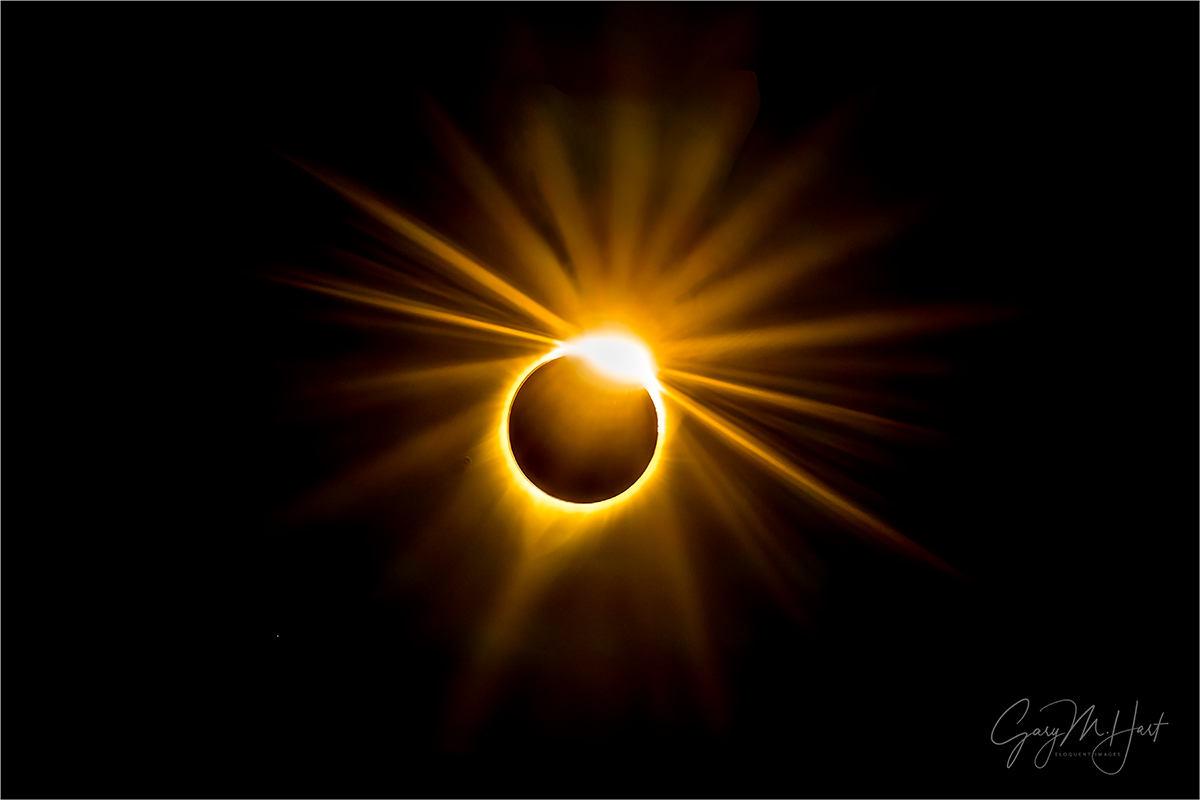
Solar Return, Total Solar Eclipse, Central Idaho (August 21, 2017)
Sony a7RII
Sony 100-400 GM
ISO 100
f/16
1/6 second
The following article isn’t a comprehensive eclipse photography how-to, but for eclipse viewers, it might be worth reading anyway
I’m getting a lot of questions about next week’s (April 8, 2024) total solar eclipse. In addition the standard “how-to” questions, many have asked if I plan to write a blog about how to photograph it. My response has been that, having photographed exactly one total solar eclipse in my life, I’m far from qualified to portray myself as an eclipse expert. But the questions keep coming, so I figured I’ll put my limited knowledge, along with some unsolicited experience-based advice, in a short(-ish) blog post with the qualifier that there are many people out there with far more eclipse photography experience than I have. And please note that the words that follow are intended for my kindred spirits, those whose passion for photography is an extension of their love of Nature—if your goal is a career-making eclipse image that you can retire on, you probably want to look elsewhere.
Safety first
And before I say anything else, don’t even think about viewing the eclipse without proper eye and camera lens protection—anything less risks permanent eye and sensor damage. Rather than try to provide safety guidance here, I’ll just refer you to NASA’s Eclipse Viewing Safety page.
Trust me
Based on my 2017 experience, my number one piece of advice to anyone lucky enough to be in position for eclipse totality is don’t get so caught up the photography that you fail to appreciate the majesty above you. I can’t emphasize this enough. For many, this will be a once-in-a-lifetime experience, and (I promise) if you’re trying to photograph it, the short duration of totality (four minutes or less) will take your breath away (like a knee to the midsection if you realize you missed it fiddling with your camera).
After my experience in 2017, my recommended approach to photographing any total eclipse while prioritizing the experience, is to put your camera on a tripod well in advance, attach your longest lens, and frame up the sun. In other words, don’t get fancy.
Trying to add landscape features to your eclipse image is probably a mistake, because during totality the sun will be so high in the sky that any (legitimate) image that includes the landscape will be so wide, the eclipse will shrink close to insignificance in the frame. Even going wide enough to include stars and planets will shrink the eclipse more than I’d prefer.
Not only will shooting a telephoto of the eclipse maximize the eclipse’s beauty, a tight frame eliminates all terrestrial objects, making your location within the path of totality irrelevant—whether you’re at a beautiful mountain lake or the parking lot of a 7/11, your telephoto eclipse images will look the same. That said, if you can be in a relatively remote area away from crowds, by all means do it. While the photography aspect won’t be any different, the multi-sensory personal aspect will be much better.
Time to start clicking
Don’t misunderstand: I’m not saying you shouldn’t photograph the eclipse—I can’t imagine witnessing something this special and not photographing it. I just want to make sure your priorities are straight before you begin. So here goes…
I think the best eclipse images happen in the few seconds before and after totality, so make sure you’re ready for both of these very brief windows. During the actual period of totality, you’ll have time to catch your breath, appreciate the view, and prepare for the sun’s return.
Though in 2017 I took a ton of images long before and after totality, I never did a thing with them—they just weren’t that interesting (a bright disk with a bite taken out). But that doesn’t mean these images didn’t have value, especially my before images, because there’s no better way to appreciate the speed of Earth’s rotation than to frame up any celestial object in a long telephoto lens and watch how quickly it exits the frame. If nothing else, even if you won’t use your before images, this is your best opportunity to gauge the sun’s pace across the frame at your chosen focal length, and its general path across the sky. In 2017, armed with this knowledge, I set a timer on my watch (can’t remember how long—30 seconds?) to remind me to check my framing. Don’t forget, the longer your focal length, the more frequently you’ll need to check your framing.
In final minute (or so) before totality, remove the solar filter (from the lens, not your eyes), stop down to f/16 or smaller (for a sunstar as the sun shrinks to nothing), and reframe the sun by moving it toward the edge of your frame to maximize the length of time until you’ll need to reframe again—ideally you won’t need to touch your camera again until after totality starts and you’ll have about four glorious minutes to enjoy a view that doesn’t change a lot. (FYI, the reason you don’t see any 2017 pre-totality sunstar images from me is because I was just a few seconds late removing my solar filter until it was too late—fortunately, I was prepared when the sun returned two minutes later.)
Don’t forget to check your exposure, both after removing the solar filter, and again when the sun is completely eclipsed. Since most of your frame will be black, your histogram will be skewed far to the left, but don’t worry about this—the most important thing is to make the remaining sunlight as bright as possible without clipping those highlights.
In the final seconds before and after totality, look for the Baily’s Beads and the diamond ring effects on sun’s perimeter (you might not see them until you view your images later). Both are brilliant splashes of light on the sun’s rim, caused when the last rays pass through irregularities on the lunar surface. Once the sun has disappeared completely, you can increase your exposure and remove eye protection (but keep it nearby—like on top of your head) until the sun returns.
Once totality arrives, a possible compositional option that will require a wider focal length is to include Venus, about 15 degrees below and right of the eclipse, and Jupiter, about 30 degrees above and to the left of the eclipse. As cool as that sounds, they’ll just be white dots, and as I said earlier, the wider focal length will shrink the sun. But if that sounds appealing, you’ll have time to do this in the four minutes of totality without completely distracting yourself from the eclipse experience. (But if you change your focal length for any reason, don’t forget to refocus.)
One potentially very cool addition to your eclipse frame is Comet Pons-Brooks, in the sky near Jupiter. On the cusp of naked-eye visibility, the comet should be visible to a camera during the few minutes of eclipse totality darkness. Don’t expect anything like 2020’s NEOWISE, but you might get a small tail that will identify the fuzzy dot as a comet, a truly rare opportunity that could set your eclipse photos apart.
If you must include landscape with your eclipse, to avoid an image that’s merely a single tiny sun somewhere near the top of the frame, you’ll probably want to do a time-lapse composite: a series of images captured at regular intervals, then combined in the computer with a before or after picture of the landscape, which will depict in one frame the eclipse’s evolution and path above the landscape. If you attempt a composite, please don’t cheat and manufacture a composite that shows the eclipse above an unrelated landscape—for example, an image of the Golden Gate Bridge with an eclipse series transposed above it (yuck). Nor should you magnify the eclipse larger than its actual size. (If you do either of these things, I don’t want to see them.) Since my 2017 composite attempt was a failure, and trying to do that composite was the distraction I most regret, I’ll refer you to the countless other photographers who have had more time-lapse success and generously offer guidance online.
A few processing points
The three images I’ve processed from 2017 (below) are cropped. Even though I used a 400mm lens (I’d have used a 200-600 if it had been available at the time), I wanted the eclipse bigger, so I cropped closer in Photoshop. Because there’s not a lot of fine detail in an eclipse image, you have a fair amount of latitude for cropping without doing great harm, so if you’re disappointed by the size of the eclipse in whatever lens you use, you’re not necessarily stuck with that.
I shoot everything in raw, which enabled me to warm the color temperature quite a bit in Lightroom. To my eyes, the eclipse looked more blue than this, but I just like my images being the yellow color we associate with the sun.
I also had to clean up some lens flair in Photoshop. Lens flair is pretty much unavoidable if the sun is in your frame, but the Photoshop Remove tool handles it pretty well.
Experience first, then photography
However you choose to photograph the eclipse, during totality step away from the camera and bask in the experience. As totality approaches, observe the sunlight’s subtle dimming, and the way shadows appear more crisply etched as the area of the sun providing illumination diminishes. With a good view of the surrounding landscape, in the final seconds you might see the moon’s shadow rapid approach before engulfing you in totality.
Now you’re eclipsed. Marvel at the sun’s corona dancing against the surrounding blackness. As your eyes adjust, look for stars, planets, and (if you’re lucky) Comet Pons-Brooks. And don’t limit your focus to the visual. When the sun disappears, note the rapturous awe, or elated celebration, of those surrounding you. Monitor animal behavior, and check in with your non-visual senses: notice the cooler temperature, listen for bird, insect, and other creature sounds to go quiet, perhaps replaced by the calls of nocturnal creatures.
There you have it, the extent of my eclipse photography knowledge. If you encounter advice from a photographer with more eclipse experience than I have, it’s entirely possible (likely) that they know more about it than I do. But don’t let them talk you into trying something so complicated that you miss your four-minute opportunity to experience one of Nature’s most special gifts, because there are no do-overs.
Now enjoy, and good luck!
Read about my 2017 eclipse experience
August 21, 2017
Click any image to scroll through the gallery LARGE
Ripping Off the Band-Aid
Posted on April 3, 2024

Frosted, Cathedral Rocks from El Capitan Bridge, Yosemite
Sony a7R V
Sony 24-105 f/4 G
ISO 100
f/13
1/10 second
We were in the midst of a beautiful Yosemite Tunnel View clearing storm when I told my group it was time to pull up stakes and move on. Some thought they’d misheard, others thought I was joking. Since we’d only started the previous afternoon, I hadn’t even really had a chance to gain the group’s trust. When one or two in the group hesitated, I assured everyone it’s like ripping off a Band-Aid, that it will only hurt for a minute and they’ll soon be glad they did it.
Many factors go into creating a good landscape image. Of course the actual in the field part is essential—things like photogenic conditions, a strong composition, and finding the ideal camera settings for exposure, focus, and depth of field. You could also cite processing that gets the most of the captured photons without taking them over the top. But an under-appreciated part of creating a good landscape image is the decision making that happens before the camera even comes out.
Some of this decision making is a simple matter of applying location knowledge. Other factors include the ability to read the weather and light, and doing the research to anticipate celestial and atmospheric phenomena (such as the sun, moon, stars, aurora, rainbows, and lightning). All of these decisions are intended to get to the right place at the right time.
A photo workshop group relies on me to do this heavy lifting in advance, and while I can’t guarantee the conditions we’ll find in a workshop scheduled at least a year in advance, my decisions should at least maximize their odds. These decisions don’t end when the workshop is scheduled—in fact, they’re much more visible (and subject to second guessing) after the workshop starts. Case in point: This morning in February.
Though the overnight forecast had promised a few rain showers followed by clearing that would last all day (yuck), before we’d even made the turn in the dark toward our Tunnel View sunrise, it was apparent the forecast had been wrong. Snow glazed all the trees, patches of fog swirled overhead, and I knew my plan to start at Tunnel View would give me the illusion of genius. At this point, my morning seemed easy.
For the next hour or so it was easy and my “genius” status remained intact as my group was treated to the Holy Grail of Yosemite photography: a continuously changing Tunnel View clearing storm, made even better by fresh snow. And if easy were my prime objective, I’d have just kept them there to blissfully bask in the morning’s beauty.
But the secret to photographing Yosemite in the snow is to keep moving, because when the conditions are beautiful in one spot, they’re just as beautiful at others. Since Yosemite’s snow, especially the relatively light dusting we enjoyed this morning, doesn’t last long once the sun hits the valley floor, our window for images of snowy Yosemite Valley was closing fast. I took comfort in the knowledge that it was virtually impossible that everyone in my group didn’t already have something truly spectacular. But, grumpy as they might have been about leaving (no one really showed it on the outside), I also knew I’d be doing them a disservice not giving them the opportunity for more great Yosemite images elsewhere in the park.
So I made the call: we’re leaving. Our next stop was El Capitan Bridge. The obvious view here is El Capitan and its reflection, visible from the bridge, but best just upstream along the south bank (actually, this bank is more east here, but since the Merced River, despite its many twists and turns, overall runs east/west through Yosemite Valley, that’s the way I’ll refer to it), but before everyone scattered I made sure they all knew about the Cathedral Rocks view and reflection from the downstream side of the bridge. Good thing.
As lovely as El Capitan was this morning, it was the downstream view that stole the show. By departing Tunnel View when we did, we were in place on the bridge when the sun broke through the diminishing clouds and poured into the valley, illuminating the recently glazed trees as if they’d been plugged in. I’d hoped that we’d make it here in time for this light, but I’d be lying if I said I expected it to be this spectacular. I hadn’t been shooting when the light hit, but when I saw what was happening I alerted everyone and rushed to capture the display before the sunlight reached the river and washed out the reflection. Some were already shooting it, but soon the rest of the group had positioned themselves somewhere along the rail to capture their own version.
Assessing the scene, I called out to no one in particular (everyone) that we shouldn’t just settle for the spot where we’d initially set up because the relationships between all the scene’s many elements—Cathedral Rocks, snow-covered trees, reflection, floating logs, etc.—was entirely a function of where they stood. With the entire bridge to ourselves, we all had ample space to move around and create our own shot.
I was especially drawn to the moss-covered tree tilting over the river on the bridge’s north (west) side. With a few quick stops on the way, I decided to go all-in on this striking tree and ended up on the far right end of the bridge. Being this far down meant losing some of the snowy trees and their reflection, but I decided I had enough of that great stuff and really liked the tree’s outline and color, not to mention the way this position emphasized the sideways “V” created by the tree and its reflection.
In general, I love the shear face of Cathedral Rocks from El Capitan Bridge (it’s a very popular Yosemite subject, especially among photographers looking for something that’s clearly Yosemite without resorting to its frequently photographed icons), but featuring the granite in this image would mean including blank sky that I felt would be a distraction. And I was also concerned that the sunlit rock just above the top of this frame would be too bright. So I composed as tightly as I could, eliminating the sky and sunlit rock, getting just enough of Cathedral Rocks to create a background for the illuminated evergreens. I was pleased that composing this way still allowed me to get more of the granite in my reflection.
At f/13 with my fairly wide focal length, getting front-to-back sharpness wasn’t a big problem, so I just focused on the featured tree. The greater concern was exposure. Sunlit snow is ridiculously bright, which meant that with much of my scene still in full shade, the dynamic range was off the charts. So I took great care not to blow-out the brightest trees, which of course resulted in the rest of my image looking extremely dark. But a quick check of my histogram told me I’d captured enough shadow info that brightening it later in Lightroom/Photoshop would be difficult.
By the time we were done here, I’m pretty sure everyone’s skepticism of my early exit had vanished, and that the brief sting from ripping off the Tunnel View band-aid was more than assuaged by the images we got after we left. By late morning, the snow was gone.
Yosemite in the Snow
Permission To Suck
Posted on March 27, 2024
True story: I once had a Yosemite workshop participant meter an El Capitan reflection scene, put her Nikon D4 in continuous-frame mode, then press the shutter and spray in a 180 degree (10 FPS) arc until the image buffer filled. Unable to contain my dismay, I asked her what she was doing and she just shrugged and said (with a smile), “It’s Yosemite—there’s sure to be something good in there.” While I couldn’t really argue, I’m guessing she wasn’t seeing a lot of growth as a landscape photographer.
Thanks to today’s digital cameras’ ridiculous frame rates, seemingly infinite buffers and memory cards, and the ease of deleting images in the field, I’m afraid this spray-and-pray approach has become all to common. A landscape photographer’s goal shouldn’t merely be an occasionally good (or even great) image, it should also be continuous improvement. So, while spray-and-pray might render nice images from time to time, clicks without consideration also inhibit growth.
I tend to fall on the opposite end of the photography continuum. Rather than taking a high volume of low-effort images (spray-and-pray), my approach carries over from my film days. Back then, a photographer who wasn’t careful might return from a photo trip to find that, between the film and its eventual processing, the photographs cost more than the trip. With my wallet forcing me to be more discriminating, I took my time with every scene, checking (and double-checking) every composition and exposure variable, and only clicked when I was confident of success. Because basically, I couldn’t afford to suck.
Times have changed. Though many digital shooters have indeed become far too casual with each frame, following the conservative film-centric approach leaves shots, and opportunities to grow, on the table. To get the most from digital photography tremendous advantages, we also need to jettison the inclination to obsessive prudence in favor of curiosity and exploration.
Because here’s the new (digital) reality: While each film click cost us money, each digital click increases the return on our investment. In other words, since we’ve already invested in the capture medium (our camera), the more times we click the shutter, the lower the cost per click becomes. Transitioning from film to digital, the realization the not being constrained by budget means that every click doesn’t need to be a winner felt like a true epiphany.
The best approach for digital landscape shooters is a hybrid of the cautious film and nonchalant digital extremes: Careful attention to detail, combined with a no-fear freedom to fail frequently. For this to work, it’s essential to have some kind of plan or objective for every frame, but that objective doesn’t have to be a good image—it can be just as valuable to fail and learn. Feel free to explore without knowing exactly where you’re going or how you might get there—some of my most successful images happened only because I wasn’t afraid to start with crappy images, just to see where they led.
There’s a draft in here
As someone who has been writing and taking pictures for a long (long) time, I’ve found true similarities between the creation process for each craft. Whether it’s an important e-mail, a magazine article, a blog, or an epic novel, few writers sit down and create a polished piece of writing in a single pass. Instead, they start with a rough draft of their idea, then review, revise, and repeat until they’re satisfied.
For most writers, success requires being okay with making “bad” before making good. In her (wonderfully insightful and entertaining) book “Bird by Bird,” Anne Lamott encourages writers to embrace the “shitty first draft.” As a writer long inhibited by a fear to ever be less than perfect at anything, I found this permission to start “bad” very empowering. Until embracing this concept, not only had my creative growth been waylaid by my own internal editor, I’d been comparing my own early attempts to everyone else’s finished work (of course it won’t compete), forgetting that those writers almost certainly started with something crappy too. Now, when writing anything, I’m far more comfortable simply starting with an idea and seeing where it leads me.
This mindset is ideal for landscape photographers as well. We deal with mostly stationary subjects, which gives us the time to create at our own speed—clicking, reviewing, adjusting to our heart’s content—confident that our subject will still be there when we’re ready for the next click. Because there’s no financial penalty for each digital shutter click, the mindset can be that each click is simply a step toward a finished image—no matter how poor the prior image, there’s always an opportunity to improve it with the next one.
When I approach a scene and think there might be a shot in there somewhere, I don’t care how many clicks it takes, I’ll just keep clicking and refining until I’ve found something, or decided there’s nothing there. I start by composing my first click mostly by feel, without a lot of analysis. This is my first draft, a proof of concept that creates a foundation to build an image on. When that draft pops up on my camera’s LCD, I stand back and evaluate it, make adjustments, and click again, repeating as many times as necessary. And even when I think I finally have it, I might try a few more tweaks to see if I can make the image even more “perfect.” Would it surprise you to know that virtually every picture I share was not my first click of that scene?
This click without remorse approach also applies when I’m not certain there’s anything there at all. In those situations I might just play “what-if” games with my camera: What if I do this? Or that? If it triggers something, great; if it doesn’t, I move on—but maybe I’ve learned something in the process. And every time I find myself asking, “Should I do it this way or that way?,” I just do it both ways and decide later.
This personal permission to be bad is probably the single most important factor in my growth as a photographer.
One more thing…
I hear a lot of landscape photographers claim that stabilized bodies and lenses, combined with clean high-ISO sensors, have made the tripod obsolete. Since photography has to make you happy, I won’t argue with anyone who says using a tripod saps their joy. But…. If the joy you receive from landscape photography requires getting the best possible images, you really should be using a tripod.
Applying my draft/revise approach without a tripod is like drawing with an Etch A Sketch (is that still a thing?), then erasing the screen after each click. That’s because after every hand-held click, what’s the first thing you do? If you’re like most photographers, to review your image you drop the camera from your eye and extend it out in front of you to better view the LCD. Before you can make the inevitable adjustments to that hand-held capture, you must return the camera to your eye and completely recreate the original composition you just evaluated before making any adjustments. Using a tripod, the image you just reviewed is just sitting there in your viewfinder, waiting for the next revision.
Much the way a computer allows writers to save, review, and incrementally improve what they’ve written, a tripod holds your composition while you decide how to make it better. Shooting this way, each frame becomes an incremental improvement of the preceding frame.
Now, go forth and suck…
About this image
When this year’s Iceland workshop group arrived at Glacier Lagoon, it was pretty clear that we were in store for something special. The shadowless light and sweet pink and blue pastels opposite the sun make early pre-sunrise (or late post-sunset) twilight my favorite time of day to photograph—in Iceland it’s even better thanks to the incredibly long high latitude twilight. With the sun rising behind us in a little more than an hour, the clear sky and pristine air meant we’d have a front row view of the day’s first pink rays pushing the steely blue Earth’s shadow below the horizon.
Since we’d already visited here a couple of days earlier, everyone in the group knew their way around and instantly scattered when they saw what was coming. I didn’t go far, setting up with several others in the group along the lagoon bank, just below the parking area. I chose this spot largely because it allowed me to stay fairly close to many in the group, while still providing all of the elements I knew would make the morning special: clear view of the soon-to-be colorful sky, striking icebergs to draw the eye, and a reflective and textured foreground dotted with smaller ice features.
With so much going on from foreground to sky, I went with my 16-35 f/2.8 lens, which was already mounted on my Sony α1 body. I had little time to waste and quickly framed up a wide shot that included everything. Scrutinizing the result, I decided that I’d use the two largest icebergs to anchor my frame and repositioned myself accordingly. Then I just started clicking and reviewing, making slight refinements to find the right balance of sky and ice, and tweaking my polarizer to maximize the reflection color while reducing the glare on the closest ice.
True to high latitude form, this morning’s show stretched on luxuriously, enabling me to work the scene without feeling rushed. If I hadn’t been with a group I might have taken advantage of the slow motion sunrise and roamed a bit, but I was pretty content just staying put.
Join Don Smith and me in Iceland next year.
Workshop Schedule || Purchase Prints || Instagram
Sweet Twilight
Click any image to scroll through the gallery LARGE
Aurora Dreams
Posted on March 19, 2024
Even without the northern lights, there’s enough stuff to photograph in Iceland to more than fill a 10-day winter workshop. But I’d be lying if I said the prime goal of every person who signs up for an Iceland winter photo workshop isn’t the northern lights. And Don Smith and I do our best to fulfill these aurora dreams, but that of course isn’t completely under our control. (Full disclosure: our motives aren’t entirely unselfish because we get as thrilled about the aurora as anyone, and would go chasing the lights by ourselves if everyone else wanted to stay in.)
To maximize our chances for success, we have aurora locations for each of our overnight towns (and multiple locations at most of them), monitor the weather and aurora activity obsessively, and use these forecasts to plan (and adjust) our schedule, sometimes days in advance.
But like most things in nature photography, nothing is guaranteed. For example, last year we had two Iceland workshops back-to-back—the first group enjoyed truly epic northern lights displays on consecutive nights, at two different locations; the second group was essentially shut out, only managing to see a faint green glow on the horizon, visible to the camera but not the eye. But that disappointment wasn’t for lack of trying.
Since knowledge is power, when chasing fickle natural phenomena like the aurora, it helps to have as complete an understanding as possible of the science involved. Not only does this understanding help me maximize my chances for success, it helps me appreciate my subjects and enjoy the experience even more.
Aurora basics
Our planet is continuously bombarded by solar energy. When this perpetual solar wind encounters Earth’s atmosphere, a narrow range of wavelengths (infrared and visible) passes through to warm us and light our way. But other energy wavelengths in the solar wind interact with the atmospheric molecules they encounter, creating a charge imbalance by stripping electrons.
Instead of penetrating our atmosphere to create havoc on Earth’s surface, most of these charged particles (ions) are intercepted by the magnetosphere, our planet’s protective magnetic shield. Continually buffeted by solar energy, the magnetosphere is teardrop shaped, with the battered side that faces the sun compressed, while the side shielded behind Earth thins and stretches much farther into space.
As Earth rotates, at any given moment the side toward the sun (the daylight side) faces the compressed side of our magnetosphere, while the night side of Earth looks out at the less dense, extended region of the magnetosphere. Just as the upwind face of a wall or building channels wind around it, the sunward side of the magnetosphere deflects the charged particles and channels them to upper regions of Earth’s leeward (night) side.
While many of these ionized molecules stream toward the back, extended part of the teardrop-shaped magnetosphere and eventually away from Earth and deeper into the solar system, some are drawn Earthward along magnetic field lines created by our planet’s north and south magnetic poles, creating an oval of charged particles lower into the atmosphere above the poles. It’s these energized particles that we see as an aurora.
The aurora’s color depends on the molecules involved, and the altitude of their activity. Green-emitting oxygen molecules at relatively low altitudes are the most plentiful, which is why green is the most common aurora color. Less common is red, which we see when charged particles strike oxygen at very high altitudes, as well as nitrogen, hydrogen, and helium at lower altitudes. Blue and purple are also possible, depending combinations of altitude and the molecules involved.
Aurora activity is measured by the Kp- (or K-) index, a 0-9 scale of atmospheric electromagnetic activity, with 0 being little or no activity (get some sleep), and 9 being the most extreme activity (don’t forget the sunglasses). Many governments and scientific organizations issue regular Kp forecasts that seem about as reliable as a weather forecast—decent, but far from perfect, and improving as the forecast day draws near. There are many websites and smartphone apps that will provide you with up-to-date Kp forecasts for your current location—some will even issue alerts.
The solar cycle
The size of the aurora oval, and therefore the extent of the area below where we’ll be able to view an aurora, is a function of the amount of activity on the sun. In times of extreme solar activity, not only will the aurora display be visible at lower latitudes, the intensity of the display at higher latitudes will be greater.
Through centuries of observation, solar scientists have identified an 11-year cycle of solar activity tied to the reversal of the sun’s magnetic poles: every 11 (or so) years, the sun’s north and south poles flip. With this solar reversal comes an increase in sunspots (storms on the solar surface) that spawn the solar flares and coronal mass ejections that hurtle energetic particles Earthward to ignite an aurora. And though strong aurora displays are possible at any time during the solar cycle, their occurrence is most frequent around the 11-year max, and least frequent around the 11-year minimum.
For anyone with aurora dreams of their own, all this is especially relevant right now because the sun is approaching its 11-year peak. It’s impossible to know exactly what month the absolute peak will occur, but the activity is still increasing and it’s safe to say that it will probably peak sometime in the next year or two. Whether you join me in an Iceland photo workshop, find some other workshop or tour, or just plan a trip on your own, the time for action is now.
This year’s aurora chase
Based on the aurora forecast, this year’s Iceland workshop group started out very hopeful. And while the aurora was indeed active during our visit, the weather didn’t fully cooperate. After a couple of nights of cloudy skies (and fantastic daytime photography) on Snaefellsnes Peninsula , we made the long drive to Vik beneath a sunny sky that gave us hope for that night’s chances. So, given the day’s horizon-to-horizon blue, it was difficult to believe when an early afternoon forecast suddenly promised clouds by nightfall. But sure enough, as we photographed sunset on the coast near Vik, we were discouraged to see clouds approaching from the south and west.
Despite our pessimism, we went to dinner with a plan to give the aurora a shot if the clouds held off. After dinner (pizza, at a small restaurant that has become an annual favorite) we were pleased to walk outside and see stars in the north. Let’s go!
One of last year’s great aurora shows happened on our night in Vik, a display so spectacular that we were able to photograph it in all directions from a location with the best views west, south, and east. But we knew that on this night, even if the clouds held off long enough, any visible aurora would likely be limited to the northern sky. And with clouds encroaching, we knew south-facing views would likely be fruitless anyway.
Unfortunately, of all the locations we visit in Iceland, Vik has the worst north-facing views. But not to be deterred, we pointed our bus up the steep hill behind the town’s beautiful little church (if you’ve been to Vik, you know what I’m talking about) until we could go no further. We found ourselves at a cemetery parking lot high above town, with an open view northward to nearby mountains and the sky beyond.
Don, Albert (our guide), and I piled out of the bus and could instantly see above the mountains the telltale greenish haze that indicates an aurora—nothing spectacular, but enough to get a group of aurora virgins out of the bus. It only took us about 60 or so seconds to return to the bus, rouse everyone, and grab our gear, but in that short time a distinct green shaft of aurora had shot along the northwest horizon. Since we didn’t know how long it would last, and we could clearly see clouds closing in from the south, we ramped up the urgency to something approaching a fire evacuation.
For the next 30 minutes, until the clouds arrived to shut down the view, the group enjoyed a beautiful aurora display. Though pretty much limited to this one region of the sky, it was quite bright—bright enough that the color was clearly visible—with visible definition and motion.
Since this was the first time photographing an aurora for most of the group, I spent most of my time making sure everyone else was doing alright and didn’t get to take a lot of pictures for myself. I just set up my camera, found a composition I liked, set my focus and exposure, then clicked an occasional frame as I passed my camera on my way to help someone else.
The aurora was more prominent on the left side of this view, but I wasn’t crazy about the foreground in that direction. I decided to put the aurora on the left side of my frame and go wider to balance it with the Big Dipper and nicer peaks. I was less than thrilled about the light from Vik painting mountains, but figured I could minimize that fairly easily in Lightroom/Photoshop.
So, did we have the spectacular aurora show of previous years? We did not. But on this one night, and this night only, we did enjoy a short-lived but beautiful aurora that fulfilled everyone’s aurora dreams.
Don Smith and I will be back in Iceland for more next year
Iceland’s Aurora
Watch Your Backup
Posted on March 12, 2024
A funny thing happened to me on the way to this image. And when I say “on the way,” I don’t mean taking the picture, I mean after it was safely loaded onto my computer and fully processed, it seems that someone (who wishes to remain anonymous), accidentally overwrote it with a completely different image. Oops.
Establishing a backup mindset
Overwriting an image is an easy thing to do; without a backup, it’s lost forever. In this case, I still had the raw file, but I’d have lost all the time and effort I’d put into processing the image, with no guarantee that I’d ever perfectly duplicate my original processing. Not the end of the world, but a real pain. Instead, since I did have a backup, I was simply able to restore the image and go about my business.
Though whole experience was just a blip in my day, it made me think about the data management practices that made it a non-event. These data practices I acquired in my previous life in the tech industry (way back when megabytes were big), but practices that might not be quite so second nature to others (especially those who don’t yet know the devastation of lost irreplaceable data). Which led me to thinking that perhaps some would be interested knowing how I keep my data safe. So I’ll share my own image (and data) workflow as an example of good data practices—not to advocate for my specific approach, but simply as an example.
However you choose to implement your own backup scheme, you should be fine long as you follow a few basic principles:
- Backup everything that’s important: Duh.
- Backup regularly—Ideally that will be automatically and as instantly as possible: Your data is only as good as your most recent backup.
- Redundant backups: Relying on a single backup of important data is playing with fire, and I daresay even two backups might not be not enough.
- At least one offsite backup: You never know what catastrophe might befall your abode.
- Multiple storage types: There is no “perfect” storage technology, so whatever your preference—spinning drives (cheaper but prone to crashing without warning); SSD drives (faster, relatively crash-resistant, and extremely compact, but expensive and not forever); CDs/DVDs (cheap, but also not forever); or the cloud (convenient but slow to populate, and even slower to restore—especially if you need to restore a lot of data at once)—never put all your backup eggs in one basket.
I’m going to concentrate on my image storage and backup, but since photography is my livelihood, there’s lots of non-image data that’s just as important and treated with the same care.
To the extent that it’s possible, for me a regular backup means an immediate backup. Because all of my cameras have two card slots and I write each image I capture to both cards, my image backups start the second I click my shutter. Card failures are rare, and usually survivable with the help of recovery software, but usually isn’t good enough. Not only that, media failure isn’t the only threat to my images. Don’t forget user error. For example, I know a photographer (the same one who overwrote the image above) who one time pulled a card out of his camera intending to upload the images from a recent weekend in Yosemite, stuck it in a pocket for the short walk down to his nearby Starbucks, and somehow lost the card. Instead of freaking out about a lost weekend, he simply pulled the other card from his camera and used it to import the weekend’s images. The stray card never did turn up, so he was out the cost of its replacement—a temporary bummer, but far from the crushing letdown losing a weekend’s worth of irreplaceable photography would have been.
As much as I’d like to automate the step of importing my images from my camera to my computer, my own import workflow does require some intervention because I use Lightroom’s Import program to name and organize my images. Without getting too deep into the weeds, I let Lightroom rename each image—retaining the camera-assigned image number and adding descriptive info—before copying them into a trip-specific folder on a 4TB SSD drive that always travels with me. And because I use two computers, my Lightroom catalog also lives on this drive—I just plug the drive into whichever computer I’m working on and away I go.
Once this Lightroom upload is complete, I immediately copy that trip’s newly populated folder onto a 10TB spinning hard drive that lives on my desk, and also to a RAID 6 configured NAS array (a possibly overkill but much appreciated backup set-up by my IT professional son-in-law). Only when all this is done do I format the camera’s media cards.
That sounds pretty good—3 copies (computer, hard drive, NAS array)—but it’s not enough. Consider the plight of Francis Ford Coppola, who lost 15 years worth of writing and images when his computer and its backup were stolen. Then think about the unthinkable things that could happen to your home—theft, fire, flood, nuclear missile, etc.—that might jeopardize everything inside. You need an offsite backup.
Places to host an offsite backup(s) include the home of a friend or relative, a safe deposit box, a storage facility, the office, to name a few. All those options are better than nothing, but not only are these manually generated backups only as good as the most recent update, updating them frequently enough to be worthwhile requires more discipline than I can take credit for.
Which is why my offsite backup uses a cloud service: Backblaze. There are many cloud backup options, but I chose Backblaze because it’s computer-based (it backs up every hard drive attached to my computer for the same price), not size limited (they’ll backup as much data as I connect to my computer), and not expensive (around $100/year). Almost the instant I add images to the 10TB drive on my desk, Backblaze recognizes the new data and starts backing it up—I never have to think about it again. With so much redundancy in my local backups, I consider this Backblaze backup to be my backup of last resort—I’ll probably (fingers crossed) never use it, but the peace of mind I get from the knowledge of its existence is worth far more than the service’s relatively small cost.
A de facto backup (it does backup my data, but that’s not why use it) is Dropbox, which holds every piece of data I might want to access regularly—processed images (but not raw files), documents, presentations, etc.—and syncs it all between my various devices. This allows me to work on something at home, then relocate to my remote “office” (Starbucks) without skipping a beat. I can also access all this essential data on my iPhone and iPad if when I find myself separated from my computers. I actually sync all of my Dropbox data to each of my computers, so once its synced I can still access it when I’m off the grid (I’m looking at you, Grand Canyon North Rim); on my iPhone and iPad, I pull most of my Dropbox data from the cloud when I need it, but do have a few important folders and files permanently downloaded for offline access.
The final piece of my backup paradigm is Mac OS Time Machine, which comes installed on every Mac, stores history for each file (I can go back to any date and recover a copy of any given file on that date), and is so easy to set up and use, I don’t understand why any Mac user wouldn’t use it. My primary Time Machine backup is a dedicated (not used for anything else) 5TB spinning hard disk that lives on my desk and is always connected. Because spinning hard drives can fail without warning, I also have a duplicate Time Machine backup on my NAS array.
In this case, when I someone overwrote a this fully processed image file, I didn’t panic, I just went to my backup. I had multiple options, but my Time Machine backup was right there on my desktop, so in less than a minute I was back in business with a fully restored image file.
One more very specific case
No example illustrates how backup obsessed I am than my workflow on a trip that requires flying. Since I’ll be so far from my whole home office backup paradigm, when I fly I carry a second 4TB SSD drive. After uploading the images onto my regular image drive and into the Lightroom catalog, I copy that folder onto that second drive, and hide it deep in my suitcase. If, God forbid, someone breaks into my room and steals my (insured) camera and computer bags, it’s unlikely they’ll find the second backup drive.
When I fly home, I make sure my images are in three different places: the primary image drive is in my computer bag over my shoulder and then under the seat in front of me; the backup drive is safely tucked into my checked suitcase; the SD cards containing the original raw files are in my cameras, which are in my camera bag on my back, and then in the overhead bin. The only way I’ll lose all three is if the plane goes down, in which case I likely have bigger problems.
About this image
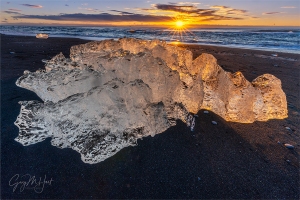
Sunrise Gem, Diamond Beach, Iceland
The day after our aborted visit to Diamond Beach, this year’s Iceland workshop group enjoyed a far more successful return visit. It seems every time Don Smith and I bring a group here, it’s a little different. Last year there was much less ice; the year before the surf was so rough that we didn’t dare get close to the water—and still ended up being too close. Some years the advancing and receding surf gently wraps each ice chunk, and other years most of the ice is high and dry.
This year the tide was out, so most (but not all) of the ice was up the beach and rarely touched by the surf. I started here trying to get the standard Diamond Beach motion blur shots on the few ice cubes the waves reached, but when the sun arrived turned my attention to the much larger ice slightly (20 feet) inland from the waves’ farthest approach.
I love the way the ice lights up with the warm hues of the sun’s first rays, so to fill the screen with this beautiful translucent natural ice sculpture, I went with my 12-24 lens, dropped low, and positioned my tripod no more than two feet away. Because I was going for a sunstar, I dialed to f/22, then spent the time waiting for the sun micro-positioning myself to get all the elements in place. I liked the smooth rocks embedded in the black sand, and though that distant block of ice in the upper left was quite tiny at 12mm, I knew as soon as the sun hit it, it would stand out enough to create a little visual interest in that corner of the frame. I put the top of my frame just above the clouds to minimize the amount of blank sky.
As soon as the sun popped out, I started shooting. On my camera’s LCD the foreground looked nearly black—not just the sand, but the shaded part of the ice as well. But I didn’t want to blow out the sky, and knew my Sony a7RV well enough to be confident I could pull up the shadows in Lightroom/Photoshop. I’d love to say that the feathery sun-kissed waves were intentional, but I didn’t even notice them until I started working on the image.
Don Smith and I return to Iceland in 2025
Here Comes the Sunstar
Click any image to scroll through the gallery LARGE





































